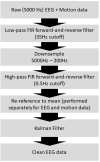The MotoNet: A 3 Tesla MRI-Conditional EEG Net with Embedded Motion Sensors
- PMID: 37050598
- PMCID: PMC10098760
- DOI: 10.3390/s23073539
The MotoNet: A 3 Tesla MRI-Conditional EEG Net with Embedded Motion Sensors
Abstract
We introduce a new electroencephalogram (EEG) net, which will allow clinicians to monitor EEG while tracking head motion. Motion during MRI limits patient scans, especially of children with epilepsy. EEG is also severely affected by motion-induced noise, predominantly ballistocardiogram (BCG) noise due to the heartbeat.
Methods: The MotoNet was built using polymer thick film (PTF) EEG leads and motion sensors on opposite sides in the same flex circuit. EEG/motion measurements were made with a standard commercial EEG acquisition system in a 3 Tesla (T) MRI. A Kalman filtering-based BCG correction tool was used to clean the EEG in healthy volunteers.
Results: MRI safety studies in 3 T confirmed the maximum heating below 1 °C. Using an MRI sequence with spatial localization gradients only, the position of the head was linearly correlated with the average motion sensor output. Kalman filtering was shown to reduce the BCG noise and recover artifact-clean EEG.
Conclusions: The MotoNet is an innovative EEG net design that co-locates 32 EEG electrodes with 32 motion sensors to improve both EEG and MRI signal quality. In combination with custom gradients, the position of the net can, in principle, be determined. In addition, the motion sensors can help reduce BCG noise.
Keywords: EEG/fMRI; Kalman adaptive noise cancellation; ballistocardiogram; position estimation.
Conflict of interest statement
The authors declare no conflict of interest. The funders had no role in the design of the study; in the collection, analyses, or interpretation of data; in the writing of the manuscript, or in the decision to publish the results.
Figures










References
-
- Mulert C., Lemieux L. In: EEG-fMRI: Physiological Basis, Technique, and Applications. 2nd ed. Mulert C., Lemieux L., editors. Volume IX. Springer; Cham, Switzerland: 2023. p. 789.
-
- Kuperman J.M., Brown T.T., Ahmadi M.E., Erhart M.J., White N.S., Roddey J.C., Shankaranarayanan A., Han E.T., Rettmann D., Dale A.M. Prospective motion correction improves diagnostic utility of pediatric MRI scans. Pediatr. Radiol. 2011;41:1578–1582. doi: 10.1007/s00247-011-2205-1. - DOI - PMC - PubMed
-
- Placidi G. MRI: Essentials for Innovative Technologies. CRC Press; Boca Raton, FL, USA: 2012. 192p
MeSH terms
Substances
Grants and funding
LinkOut - more resources
Full Text Sources

